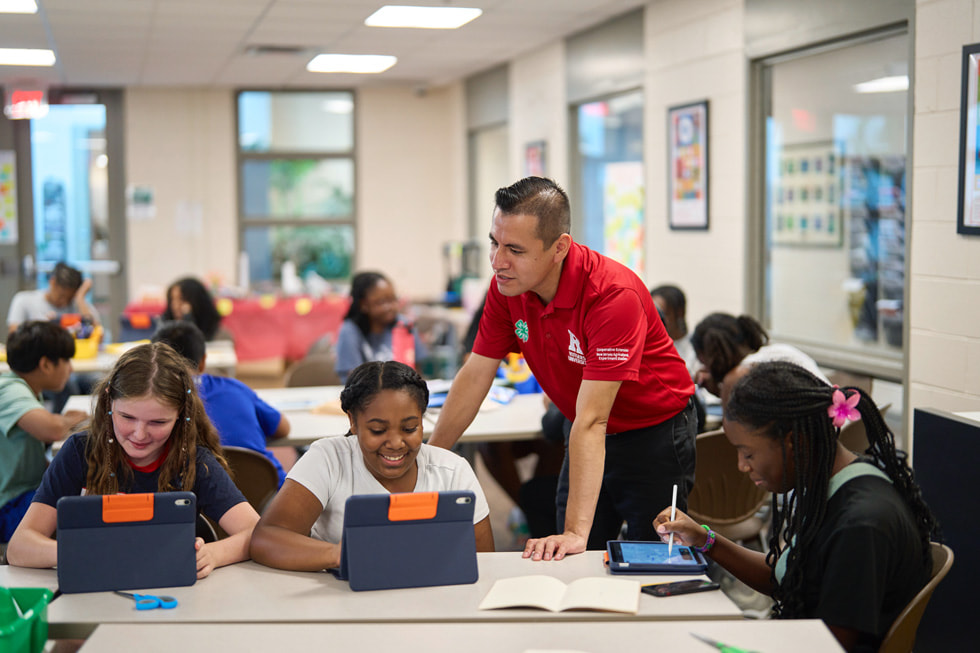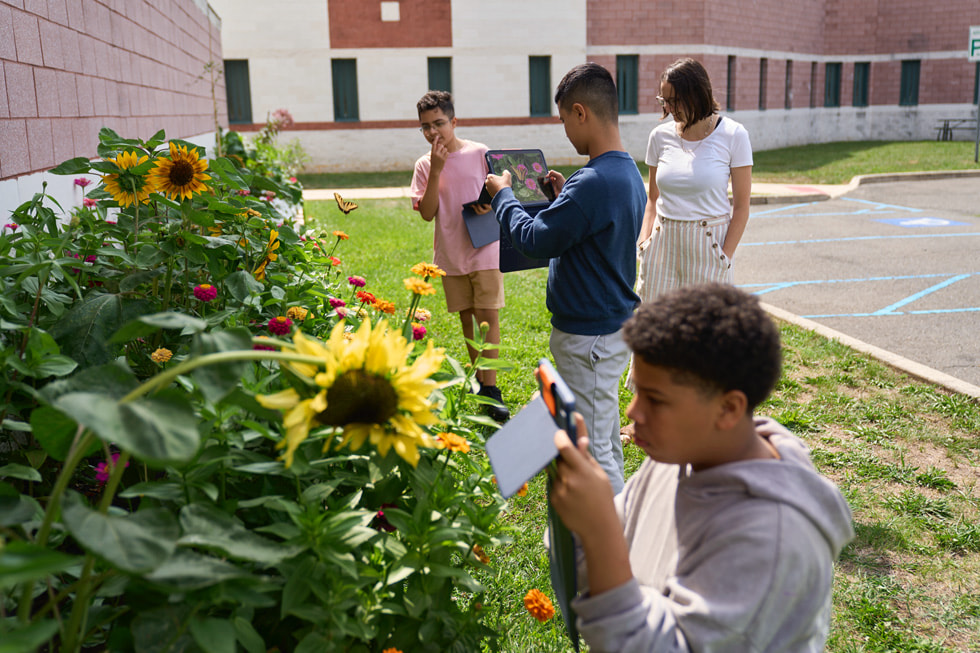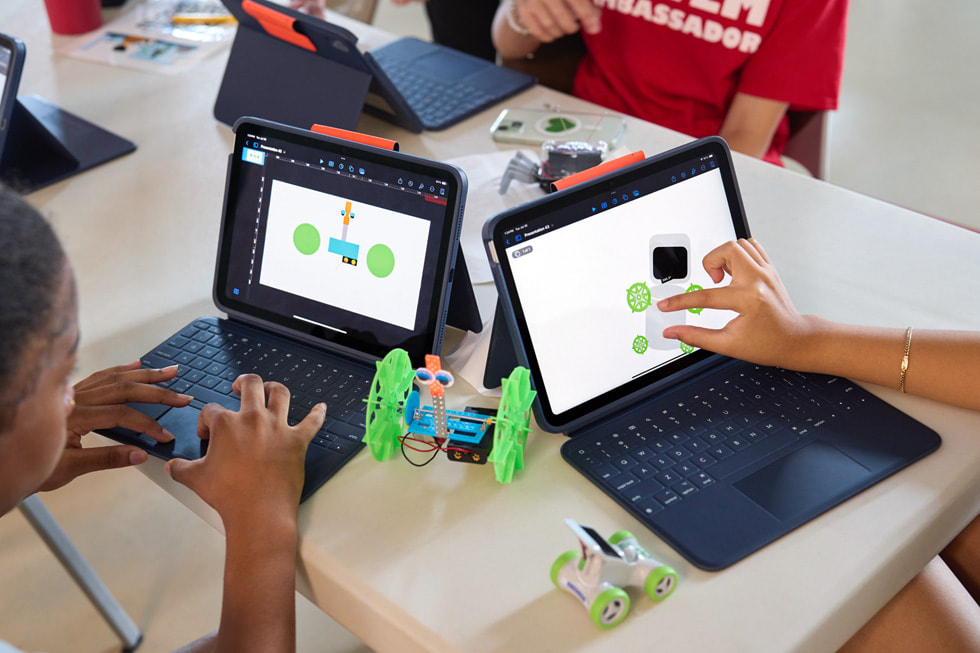apple stories
Apple and 4-H are bringing technology to a new generation of learners
The name 4-H traditionally conjures up images of teenagers raising farm animals, or learning how to bake or sew — and those skills are still a big part of the organisation that has helped support and educate young people across America for more than 100 years. On a recent day at the Franklin County Fair in Columbus, Ohio, 4-H club members presented livestock and displayed quilts they had crafted, but on closer inspection, there were signs of something new, and perhaps surprising.
Outside a 4-H mobile classroom bus parked near the fair’s showgrounds, kids were using iPad to drive Sphero robots across the pavement, while inside, they were coding with Swift and composing music using GarageBand.
In a nearby barn, 15-year-old Calum Williams was preparing to show one of the ducks he raised by reviewing Notes on his iPad.
“I like how 4-H is very inclusive,” says Williams. “Even if you’re not interested in livestock or sewing or cooking, which 4-H is really known for, there are a lot of other things you can do that incorporate technology, like STEM projects. 4-H has changed a lot, and it’s still changing.”
4-H is the largest youth development organisation in the US, reaching more than 6?million young people across every county and parish in the nation each year. The organisation is directly tied to land-grant universities, which were created in the late 19th century to increase admittance to higher education, with an emphasis on agricultural and engineering skills.


In recent years, 4-H has expanded to include greater access to technology, thanks in part to support from Apple and its Community Education Initiative (CEI). Since Apple launched CEI in 2019, the programming has provided coding, creativity and career opportunities to tens of thousands of students in 99 countries and regions, and across all 50 US states, with an emphasis on communities that are traditionally underrepresented in technology. CEI is part of Apple’s broader commitment to education and educational equity, dating back more than four decades.
Apple’s work to bring cutting-edge technology to one of America’s most cherished community programs started in Ohio in conjunction with The Ohio State University, providing hardware, financial support, scholarships, educator resources, and access to Apple experts. The collaboration has grown significantly since that initial partnership in Ohio. Between 2019 and spring 2024 in the US, Apple-supported 4-H programs reached thousands of educators and more than 90,000 young people across Ohio, New Jersey, Michigan and Florida, including through programming at Historically Black Colleges and Universities. By the end of this summer in the US, nearly 8,000 more students will have been introduced to the program, with expansions into Illinois, Kentucky and Idaho. Programming in North Carolina is set to begin this autumn in the US, in collaboration with North Carolina State University.
Jobie Thinthapthai, 12, has been part of 4-H for four years. At this year’s Franklin County Fair, in addition to showing the pig and rabbit she raised, she visited the 4-H mobile classroom bus for the first time. The bus is outfitted with iPad stations where kids can explore robotics, coding, music composition and art.
“It was really cool, and I especially liked working with the robots and drawing on iPad,” says Thinthapthai, who wants to be a doctor when she’s older. “Medicine is constantly advancing with technology, so learning about that can help with my future. And it’s the same with 4-H — technology is giving us more tools to use with our projects, so we’re learning skills that we can use later on in life.”
Mark Light is one of the educators who runs the 4-H bus. He started his career as a civil engineer before joining 4-H to lead STEM programming in Ohio.
“In our state, we have 200 different 4-H project areas for kids to explore, and only 10?per cent are livestock- or agriculture-related,” says Light, who was a 4-H club member in high school. “Technology is a big part of 4-H, and when kids pick up an iPad or Apple Pencil on the bus, it becomes the spark that gets them excited about learning new skills. I love when we have parents saying ‘It’s time to get off the bus and go on fair rides,’ and the kids don’t want to leave because they’re so engaged.”
In New Jersey, Apple began partnering with Rutgers University-Newark and 4-H clubs through the 4-H Computer Science Pathways project in 2021. The program uses peer mentors from college and high school to engage young people and build skills in STEM.
“The magic of this program, and of Apple technology, is that the hands-on experience makes our young people realise that they can succeed in STEM fields,” says Rodrigo Sanchez Hernandez, who studied mechanical engineering and now helps run 4-H programming in New Jersey. “When they see someone that looks like them and is close to their age teach these advanced topics in a relatable way, they think, ‘If they can do it, why can’t I?’”
Since 2021, the program has expanded to 4-H clubs throughout the state, including this US summer’s STEM Explorers camp in Trenton. Over the course of the month, several dozen students in grades 7 through 9 cycled through iPad-based workshops that included digital media, robotics, coding and engineering. The digital media week featured a learning lab based on Apple’s Everyone Can Create curriculum that culminated in each student designing a project to bring awareness to environmental issues.



In Michigan, Apple works with Michigan State University and 4-H to help give young people the skills to explore careers in technical and creative disciplines in the Detroit area, as well as in Michigan’s Tribal Nations and communities. This summer in the US, nearly 80 young people, many of whom are affiliated with a tribal nation, attended a 4-H camp in the Hiawatha National Forest, where they used iPad and Apple Pencil to create Keynote presentations on how to build robots.
Back at the Franklin County Fair, the judging had just finished for Calum Williams and his duck. He had been preparing for months — recording his duck’s changing weight in Notes since it hatched, as well as taking photos with the camera on his iPad.
Once all of the competitors had presented their animals, the judge announced the results. Calum had won second place, and the only person that looked happier than he did was his mum, Danielle Moeller Williams.
Moeller Williams was a 4-H club member when she was growing up, and it’s the reason her son joined the organisation.
“When I started, there weren’t as many projects to do as there are now,” says Moeller Williams. “I think with all the advancements in technology, there are just so many more opportunities for the kids to get involved. 4-H has showed Calum how to use technology to prepare for his future, and I’m so incredibly proud of how he’s embraced it and the young man he’s become.”
Share article
Media
-
Text of this article
-
Images in this article





